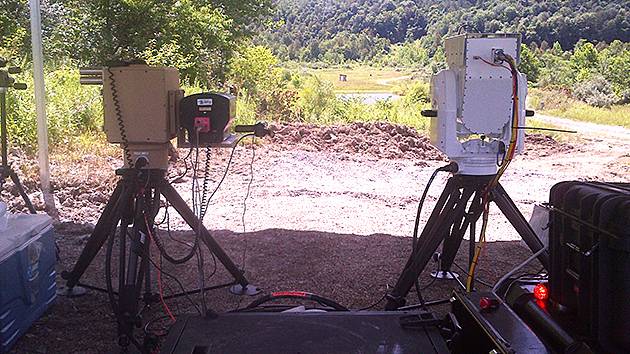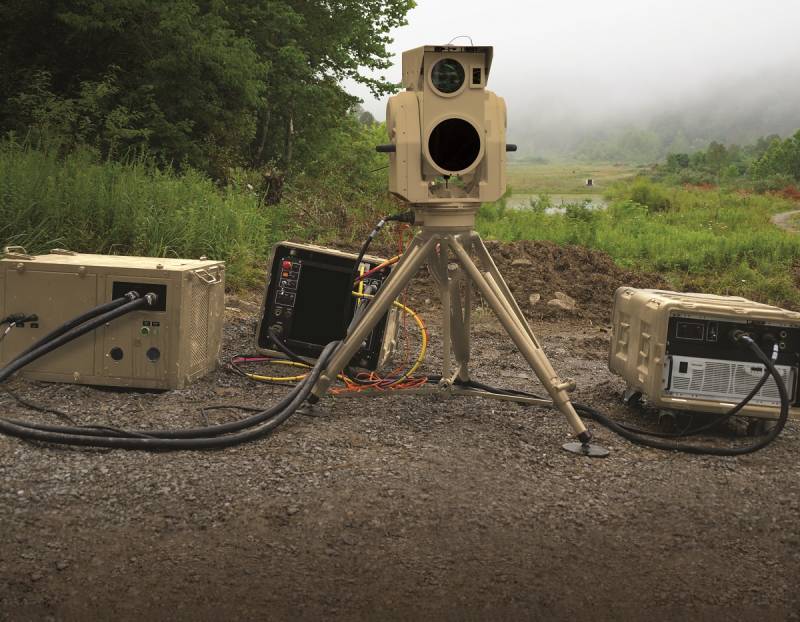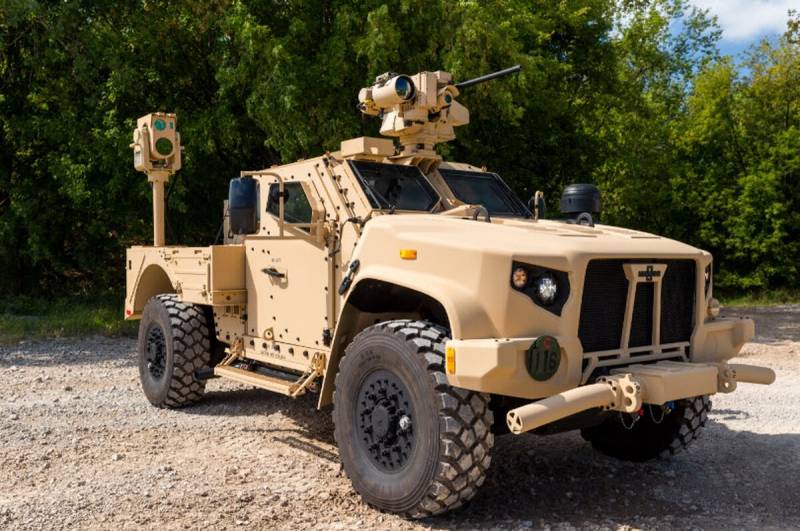Project Boeing CLWS. Laser Air Defense for the Pentagon
Compact Laser Weapon System
The company Boeing for a long time engaged in the subject of combat lasers and regularly demonstrates new developments in this area. In 2015, the premiere of another such development took place - the Compact Laser Weapon System (CLWS or CLaWS) light and compact laser complex. Such a weapon It was proposed to combat unmanned aerial vehicles and other targets exposed to thermal energy.
The CLWS complex consists of several main components. The main unit is a unit with an emitter and optical devices, mounted on an installation with pointing drives. The complex also includes some other systems, such a remote control panel and power supply devices.
In 2015, the developer company demonstrated the capabilities of the CLWS product. Automatics took the target drone to escort, and the combat laser successfully set it on fire. In the future, the tests were continued. In the course of such checks, work algorithms were studied and tested, and the design of the complex was improved.
Prototypes of the CLWS / CLaWS light combat laser were mounted on tripods. At the same time, the project provided for the possibility of placing the equipment on any land carrier - first of all, on various self-propelled vehicles. To increase the flexibility of use, it was also proposed to develop several versions of a laser of different power. The first to test out the system capacity of 5 kW. In the future, it was planned to make samples on 2 and 10 kW.
Laser for ground forces
The ground forces became interested in the Boeing CLWS project, and rather quickly such interest led to real results. In 2016, a new type of 2-kilowatt laser was tested by the army. Also tested new weapons in the framework of the Maneuver Fires Integrated Experiment. Despite some complaints, CLWS handled most tasks.
To participate in the Maneuver Fires Integrated Experiment, the combat laser was mounted on a standard armored car of the JLTV army. A control panel was installed in the cab of the car, and a block with an emitter was placed on a rack above the cargo area. Such an arrangement made it possible to carry out a round-trip and control almost the entire upper hemisphere. JLTV with CLWS successfully coped with the search and destruction of a conventional enemy UAV.
In the future, as the project developed for the army, plans to modernize a self-propelled combat laser were mentioned. The army planned to order a more powerful radiator. A laser with a power of 10 kW should be tested at 2019. In the meantime, troop tests of a less powerful system are continuing.
According to known data, CLWS combat lasers have been repeatedly used in various exercises. It was reported on the participation of such equipment in maneuvers at European test sites. The transfer to another continent confirmed the high strategic mobility of the complex while maintaining the basic combat qualities.

Despite remarkable successes, the CLWS product has not yet been officially adopted by the US Army. Troop trials continue and take some time. In the near future, a new version of the complex should appear, which is also planned to be tested in the troops. According to the results of all inspections a final decision will be made. CLWS has every chance to enter service and strengthen the air defense of military units.
For Marine Corps
A few days ago it was announced that the laser complex from Boeing comes in parts of the ILC. This structure also understands the risks associated with the enemy's UAV, and intends to take the necessary measures. Given the experience of colleagues from the army and the achievements of the industry, the Marine Corps decided to test the laser system CLWS / CLaWS.
It is particularly noted that the CLaWS prototypes will be the first laser systems deployed in parts of the ILC. To date, the Corps did not have such weapons. Nevertheless, the requirements of the time force him to study and implement modern and promising developments.
In the field of laser weapons, the ILC lagged noticeably behind its main rival in the army. For this reason, it is proposed to continue work at an accelerated pace and decide on the future of CLaWS in the near future. It is noted that from the launch of the new program of the ILC to the delivery of the first samples in part, only a year passed.
Current plans include installing the CLaWS on one of the regular ILC chassis for use in the interests of air defense. The command considers modern UAVs a serious threat, which requires special means to combat. In this context, the opinion of the command of the ILC does not differ from the views of the army.
Technical details of the project for the ILC have not yet been clarified. The exact type of chassis for installing the CLaWS remains unknown. Also not mentioned is the power of the selected laser and, as a result, other combat characteristics. Perhaps the customer has not yet made a choice, and such questions will be resolved as the tests are conducted.
Perspective development
To date, a number of different-purpose battle lasers have been created in the USA, and in this respect the Boeing CLWS / CLaWS is not something new or unique. Nevertheless, this development occupies its niche and copes well with the tasks. Appearing on time and showing the required characteristics, the CLWS complex was able to interest potential customers in the form of two types of US troops.
CLWS was able to reach the stage of military trials and is now counting on adoption. Such results are directly related to a number of characteristic advantages. First of all, CLWS differs from Boeing in its small dimensions and weight, as well as in its convenient modular architecture. This allows you to mount equipment on a variety of carriers, from cars to armored vehicles. The army has already chosen its standard JLTV armored car, while the International Police Commission has not yet disclosed the desired carrier.
An important feature of CLWS / CLaWS is the presence of several modifications with emitters of different power. The customer gets the opportunity to choose one of the three lasers that best suits his requirements. At the same time, the other components of the complex are unified. This feature also simplifies the upgrade process.
The most important factor should be considered the best fit to the tasks. Currently, combat lasers are considered one of the best means of combating light UAVs. They combine good combat qualities with a reasonable cost of combat use. The laser power is sufficient to burn through plastic parts. drone and damage to internal units, and a “shot” with a beam costs much less than a projectile or anti-aircraft missile.
Thus, the recent successes of the Boeing CLWS complex look logical and even expected. One of the structures of the Pentagon showed interest and launched a full test cycle, the results of which such a system can enter service. Now the tests will hold and Marine Corps. KMP plans to perform all the necessary work during the year. This means that new CLaWS messages may appear as soon as possible.
- Ryabov Kirill
- Boeing Company / boeing.com, Marinecorpstimes.com


Information